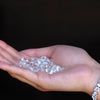
What is Diamond Fire: Unveiling the Sparkle's Secret
When discussing diamonds, you'll often hear about their incredible sparkle and the way they catch the light. This phenomenon is commonly referred to as 'diamond fire', and it's one of the most captivating attributes of a well-cut diamond. Fire refers to the colorful flashes that emerge from a diamond as it moves under a light source. These vibrant spectrums of color are not just a random occurrence; they're the result of light splitting into various wavelengths as it passes through the diamond.
Table Of Contents
Understanding diamond fire involves a bit of science. When light enters a diamond, it bends, slows down, and is fractured into a rainbow of colors, a process known as dispersion. The cut of the diamond greatly influences how light is dispersed and thus affects its fire. A well-cut diamond with proper angles and symmetrical facets will display an impressive and balanced display of colors.
My appreciation for diamond fire grew when I learned how crucial the cut of the diamond is in this respect. The round brilliant cut, for instance, is engineered specifically to enhance both the light return, or brilliance, and the fire of the diamond. This precise geometry maximizes the balance between these two desirable effects, making it one of the most popular diamond cuts in the market. Each of its 58 facets plays a role in the dance of light within the diamond, contributing to the mesmerizing display it provides.
What Is Diamond Fire
Diamond fire refers to the colorful flashes of light that resemble a rainbow, which you can see when a diamond is moved under a light source. It's the visual effect that occurs when white light enters the gemstone, gets broken up into a spectrum of colors, and is then reflected back to the eye. This phenomenon is also known as dispersion.
| Aspect | Description |
|---|---|
| Definition | Refers to the colorful flashes emitted by a well-cut diamond under light. |
| Phenomenon | Result of light splitting into various wavelengths as it passes through the diamond. |
| Science | Involves dispersion, where light bends, slows down, and is fractured into a rainbow of colors. |
| Influence | Greatly influenced by the cut of the diamond, enhancing its brilliance and fire. |
When I observe a diamond closely, I can see that the fire is due to the unique properties of this gem. The structure of a diamond acts like a prism, separating the light into its constituent colors much like when sunlight passes through a raindrop to create a rainbow.
The qualities of the fire in a diamond are influenced by various factors:
- The diamond's cut: Precision in the cut optimizes the fire.
- The light environment: Bright, direct light enhances fire more than diffuse light.
- The movement of either the light or the diamond: Movement can increase the observable sparkle and fire.
Here's a quick breakdown of why diamond fire occurs:
- Entrance of Light: White light enters the diamond.
- Refraction: The light bends as it slows down inside the gem.
- Dispersion: The bent light splits into a spectrum of colors.
- Reflection: Colors bounce off the internal facets.
- Observation: The colorful sparkle is visible when the light exits the diamond.
It's these vibrant, fiery sparkles that often draw people to admire diamonds, as they add a dynamic and mesmerizing element to the sparkle that is already present due to the stone's natural brilliance.
Properties of Diamonds
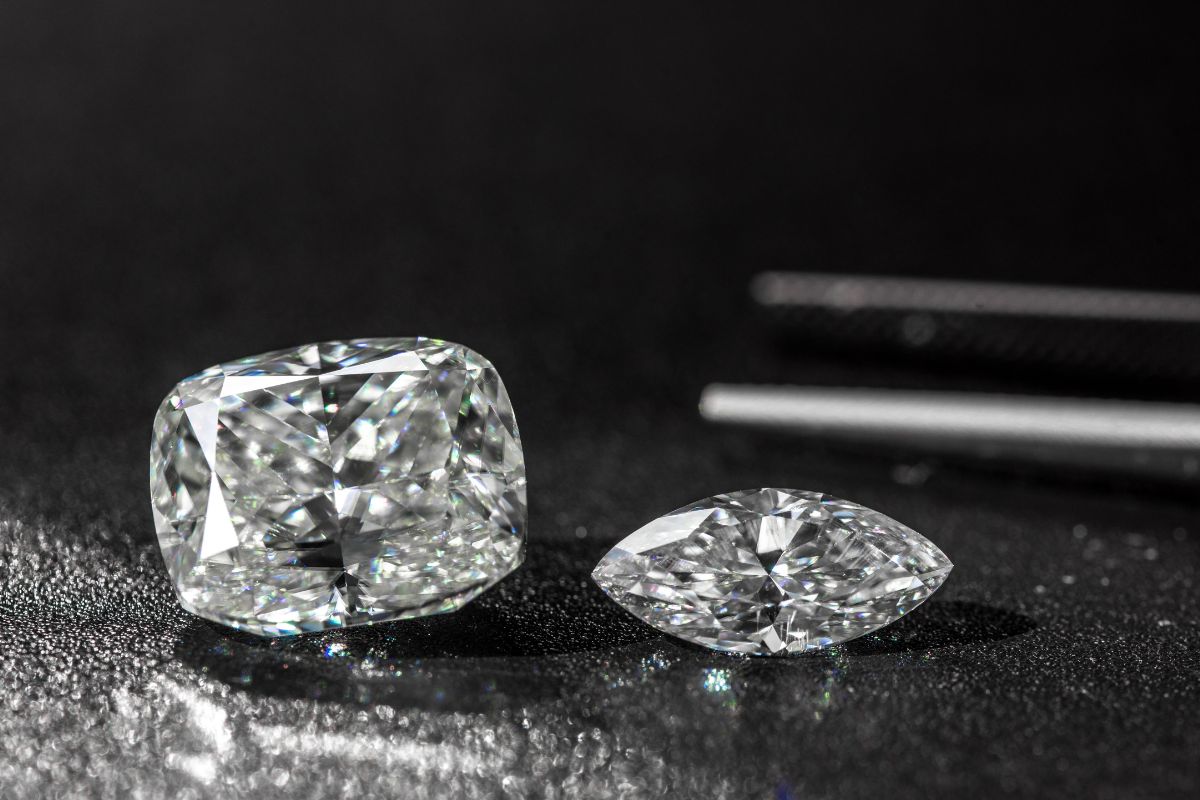
Diamonds possess unique characteristics that establish their value and beauty in the world of gemstones. As I explore the properties, I will pinpoint their optical traits, clarity grades, and color classifications, which together contribute to the overall allure of diamonds.
Refractive Index and Dispersion
Diamonds are renowned for their high refractive index, which measures at approximately 2.42. This significant refraction of light is what gives diamonds their extraordinary brilliance. Moreover, diamonds possess a property known as dispersion, often referred to as "fire," which describes their ability to split white light into constituent colors, akin to a prism. The higher the dispersion, the more pronounced the fire, providing that rainbow-like effect that is highly cherished.
Clarity and Inclusions
The clarity of a diamond is assessed based on the presence of internal characteristics called inclusions, as well as surface defects known as blemishes. These features are natural and form during the diamond's creation in the Earth’s mantle. Clarity is graded on a scale from Flawless (FL) to Included (I). Fewer inclusions generally increase a diamond's value, with diamond clarity levels such as VVS (Very Very Slightly Included) and VS (Very Slightly Included) being desirable for their minimal inclusions which are often indiscernible to the naked eye.
Color Grading
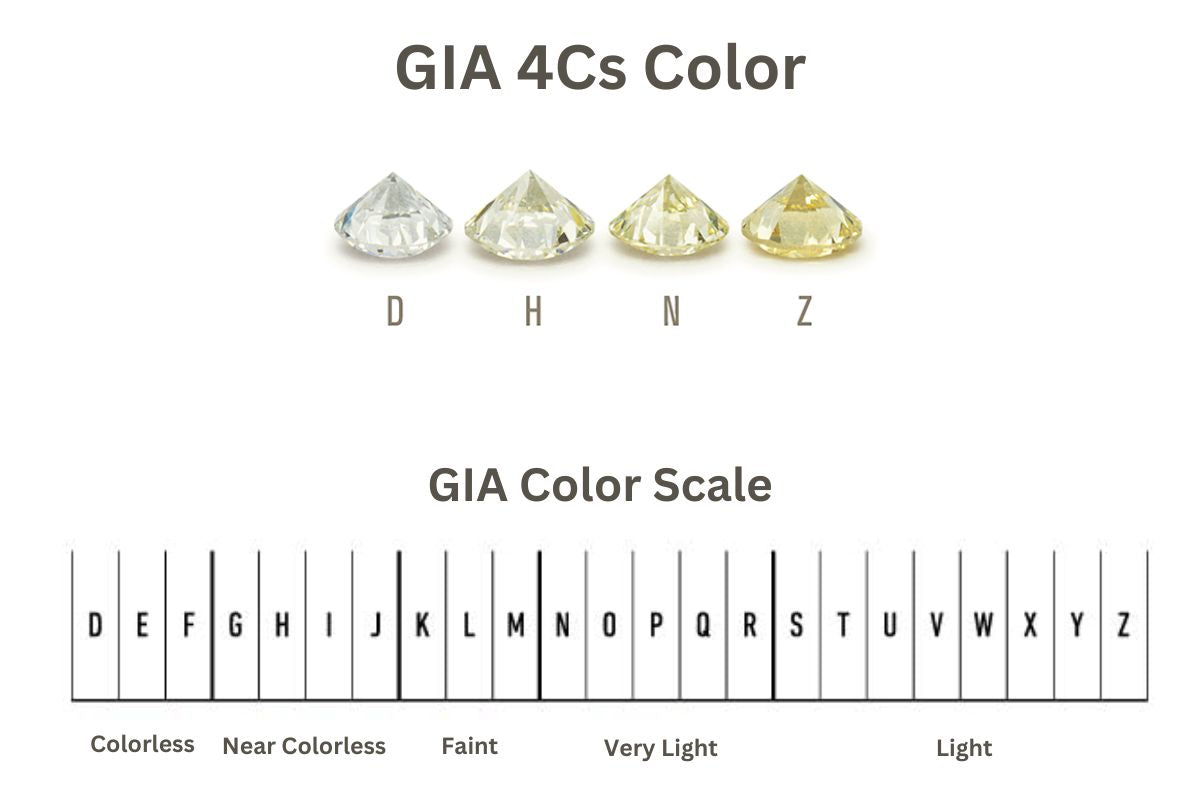
The color of a diamond is typically graded from D color (colorless) to Z, which indicates a light yellow or brown hue. Colorless diamonds are highly prized, although fancy color diamonds—those with distinctive hues like blue, pink, or yellow—are also highly valuable and sought after. The grading scale doesn't just jump from one grade to the next; there are subtle variations that can affect a diamond's value. Specific color grades like K color can hint at slight tones, which might be less valuable than a D color diamond, but may appeal to those who appreciate a warmer appearance.
Diamond Cut

When I examine a diamond, its cut is the defining factor that influences its brilliance and beauty. A well-cut diamond reflects light internally from one mirror-like facet to another and disperses it through the top of the stone, resulting in a display of brilliance and fire. Let's look at how cut quality, proportions, and symmetry determine the overall appearance of a diamond.
Cut Quality and Brilliance
I understand cut quality to be the most crucial aspect influencing a diamond's brilliance. Brilliance is the total light reflected from a diamond and is a direct result of its cut. The angles and finish of any diamond cut determine the diamond's ability to handle light, leading to its brilliance. A high cut quality maximizes the diamond's brightness and creates vigorous light return, while a poor cut does the opposite.
Diamond Proportions and Symmetry
Diamond proportions—namely the depth, width, and uniformity of the facets—significantly affect a diamond's capacity to reflect light. Diamonds with deep or shallow cuts lose light through the sides or bottom, reducing perceived brightness. Symmetry refers to the precision of a diamond's shape and arrangement of facets, which should align and intersect at precise angles to optimally guide light through the diamond. My scrutiny of diamond proportions and symmetry is essential to evaluating its potential for fire and sparkle.
Ideal Cut Diamond
An ideal cut diamond represents a specific set of proportions and angles perfected to achieve the maximum level of brilliance. This precise cutting style maximizes light return from the top of the diamond. The concept of an ideal cut is not subjective; it is based on mathematical formulas and empirical analysis. This cut aims to strike a balance between the diamond's brilliance, fire, and scintillation, constructing a breathtaking display of light.
In my analysis, an ideal cut diamond serves as a benchmark against which all other diamond cuts are evaluated, providing a guide to consumers seeking a diamond with the finest light performance.
Scintillation and Sparkle
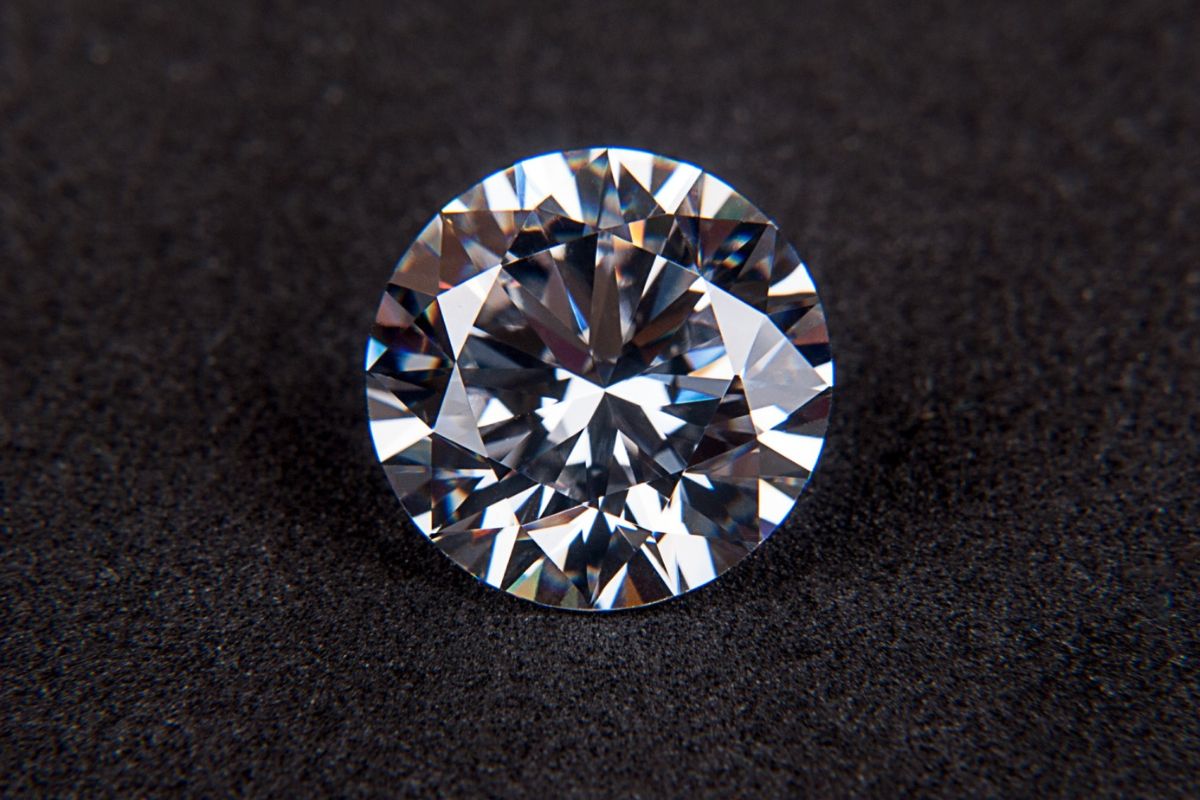
As a gemologist, I focus on the dynamic aspects of diamonds, particularly on how scintillation—the pattern of light and dark areas seen as the diamond, light source, or observer moves—plays a crucial role in a diamond's allure. When I describe sparkle, I refer to the flashes of light that emanate from the diamond as it moves, a direct result of scintillation.
Light Interaction and Contrast
In my analysis, light interaction and the contrast between light and dark areas are fundamental to scintillation. I've observed that every facet of a diamond acts as a mirror, reflecting and refracting light. The areas of a diamond that are in shadow, typically due to the observer's head blocking the light source, create contrast, making the bright parts seem even brighter. This contrast is essential for the sparkle that so many individuals find captivating.
- Reflected Light: Bright areas
- Blocked Light: Shadowed areas
- Contrast: The interplay between the two, producing scintillation
Effect of Lighting Conditions
My experience has shown that lighting conditions heavily influence a diamond's scintillation. Under bright, direct light, such as LED lighting, the sparkle can be pronounced. Diamonds exhibit their best scintillation under a mix of light sources or with movement in the light, which is why they often look most brilliant in mixed lighting or sunlight. The quality and angle of the light are crucial factors that determine how lively and extraordinary the sparkle will be.
- Optimal Lighting: A blend of direct and ambient light sources
- Poor Lighting: Minimal contrast, resulting in less scintillation
In summary, my study of diamond scintillation and sparkle has consistently revealed that the interplay of light and the diamond's ability to manipulate it through reflection, refraction, and contrast under varying lighting conditions are what make each diamond uniquely captivating.
Optical Phenomena
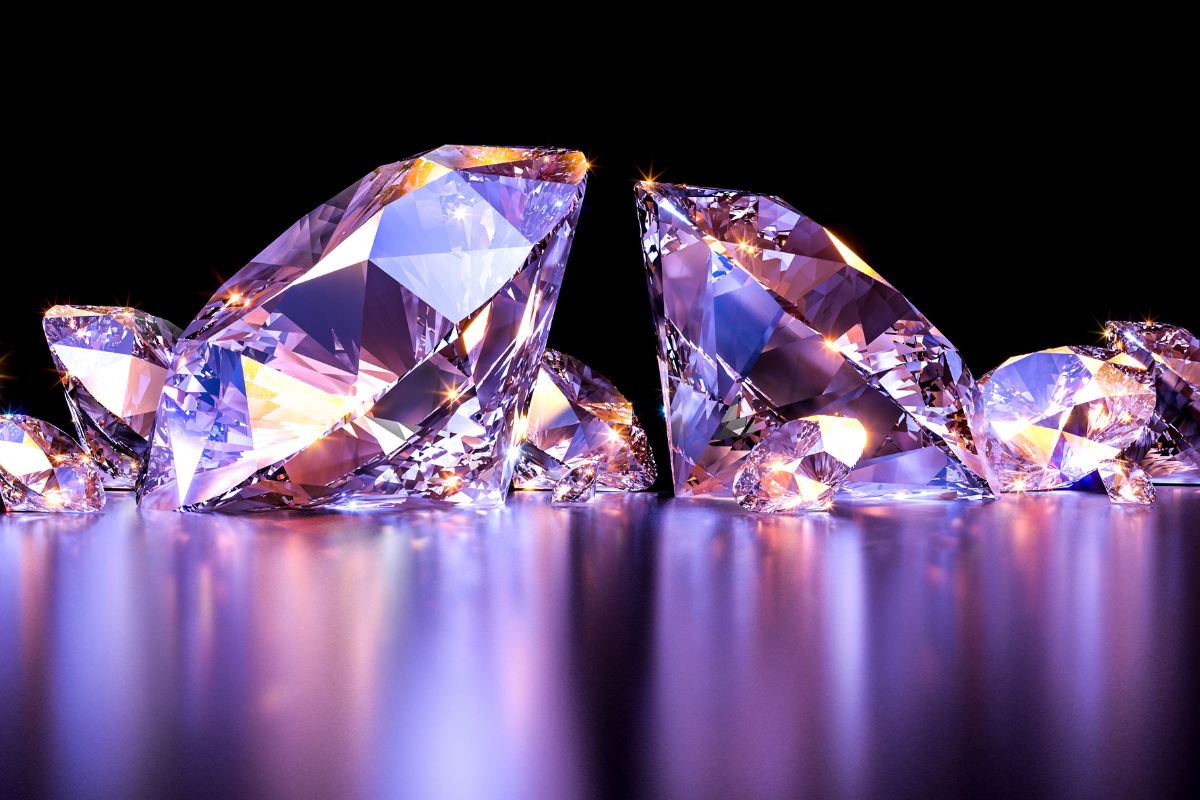
In the realm of precious stones, diamond fire refers to the captivating play of colored light that results from a diamond's interaction with light. My discussion centers on the intrinsic elements that cause this spectacle and its significance within the context of a diamond's light performance.
Cause of Diamond Fire
Diamond fire is primarily caused by the refraction of light as it passes through the diamond. When white light enters the diamond, it is separated into its constituent wavelengths, creating a rainbow effect. This phenomenon is a result of the diamond's high dispersion; as light exits the stone, the different colors are spread apart akin to a prism, producing the fiery display. The size, shape, and placement of a diamond's facets play a crucial role in this process, optimizing the refraction and the subsequent rainbow light effect.
Importance of Light Performance
The term light performance encompasses how well a diamond interacts with light, reflecting its overall appeal and quality. Light performance grading measures attributes like brightness, fire, and scintillation (colored sparkle). A diamond with excellent light performance will exhibit a dynamic balance of bright, white reflections with intense colored sparkle, ensuring both its brilliance and fire are prominent. Such metrics are pivotal when evaluating a diamond's quality, as they are indicative of the cut skill and the inherent beauty of the stone. My focus on diamond fire underscores its influence on a diamond's allure and its central role in light performance assessments.
Diamond Cut Analysis
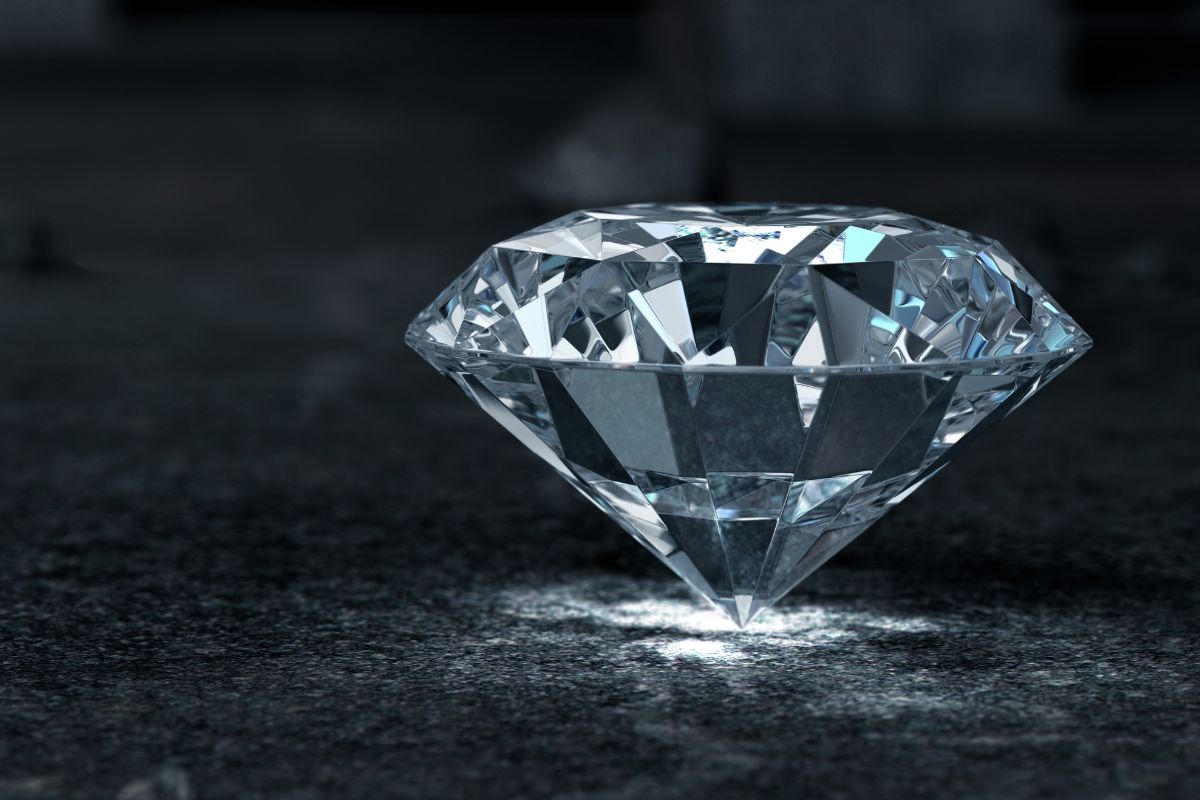
In assessing diamond fire, I find it critical to examine the cut, which greatly influences a diamond's interplay with light. Here, I'll delve into the role of facets and the criticality of facet angling and alignment in maximizing a diamond's brilliance.
Role of Facets
Facets are the flat surfaces on a diamond that are polished during the cutting process. My analysis distinguishes between two types: physical facets, which are the actual polished surfaces, and virtual facets, which are the reflections of the physical facets within the diamond. The number, size, and shape of these facets control how light enters and exits the diamond, affecting its fire. I've observed that with more facets, there can be an increase in fire as light has more opportunity to reflect and refract within the diamond.
Angling and Alignment
The angles and alignment of the facets are paramount. The crown angle, which is the angle of the diamond's crown facets in relation to the girdle plane, and the pavilion angle, the angle of the pavilion facets, need to be precisely cut for optimal light performance. I've noted that misalignment can lead to light leakage, diminishing the fire. Proper alignment ensures each facet works cohesively to reflect light internally and back out to the observer's eye. This harmony maximizes the fire and brilliance, confirming that meticulous angling and alignment are essential for a diamond to exhibit its full beauty.
Jewelry and Diamond Selection
When I discuss diamond selection for jewelry, the key elements that come to mind are the cut of the diamond and the specific attributes to consider when choosing a piece. Being well-informed is crucial, as it ensures the diamond's best appearance within a given budget.
Importance of Cut in Jewelry
The cut of a diamond significantly impacts its brilliance, and thus, the overall appearance of the jewelry. A well-cut diamond will reflect light beautifully, manifesting what is often referred to as 'fire'. This effect is the colorful sparkles that are produced when light disperses. As a confident buyer, my priority is to look for a cut that enhances both the stone's brilliance and fire. James Allen and Whiteflash are reputable vendors known for their high-quality cuts, offering precise information on their diamonds' cut grades.
Selecting a Diamond
When selecting a diamond, it's essential to consider the following:
- Carat: It refers to the diamond's weight. However, a larger carat does not always mean a better diamond. My focus should rather be on cut quality to maximize the stone's fire.
- Budget: Before I start shopping, establishing a budget is crucial. I stay mindful that my budget needs to account not just for the diamond, but also the setting and any additional stones or customization.
- Consumer Choice: Personal preference plays a significant role. I recommend exploring a variety of shapes and settings to see what resonates with me.
- Buying a Diamond: The process can be complex, so I ensure any retailer I consider offers a detailed education center on their website. I am keen on transparency and prefer vendors who provide thorough information about each diamond's characteristics.
Making a confident and knowledgeable choice in diamond selection boils down to understanding these details and how they contribute to the jewelry's final appearance.
Grading and Certification
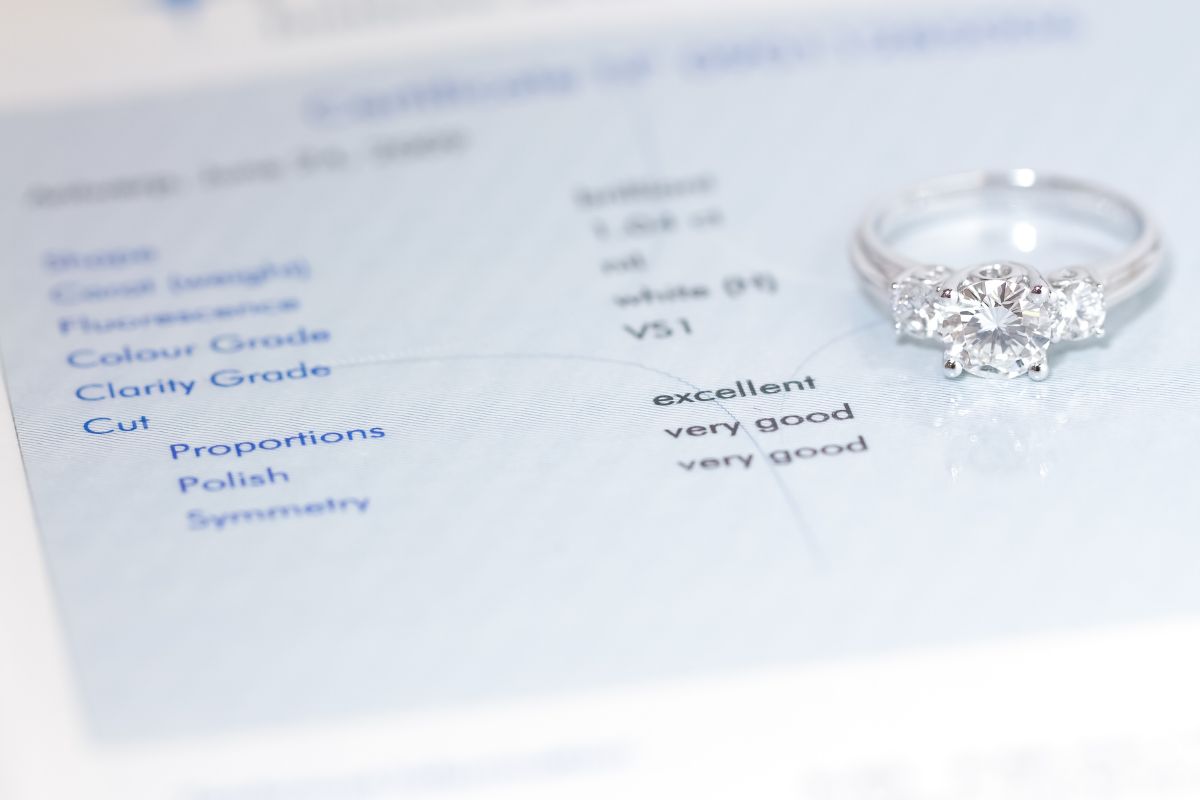
When assessing a diamond's fire, two crucial components I consider are the grading scales used to evaluate the diamond's light performance and the certification entities that validate these assessments. These components ensure that the diamond's fire is accurately represented and recognized.
Grading Scales
Diamond grading scales are instrumental for categorizing the quality of a diamond's fire. My approach includes a range of grades that describe light performance, with Excellent representing the top-tier where fire is maximized, followed by Very Good, where fire is pronounced but slightly less than excellent. The Good category still shows fire but not as vividly. In contrast, diamonds rated as Fair or Poor show diminished fire, often due to less optimal cutting proportions which impact light reflection.

- Excellent: Optimal fire and brilliance
- Very Good: Slightly less fire than excellent, but still impressive
- Good: Moderate fire, noticeable but not captivating
- Fair: Reduced fire, often seen in diamonds not cut to ideal proportions
- Poor: Minimal fire, often due to poor cut quality
Certification Entities
Certification by reputable entities is crucial for my trust in the grade a diamond receives. Organizations such as the American Gem Society (AGS) and their AGS Laboratories are known for their stringent grading standards and contribution to the grading and certification commission. With a certificate from a recognized body, my confidence in the grading's accuracy is bolstered.
- American Gem Society (AGS) Laboratories: A leading entity in diamond grading, known for its creation of the AGS Performance-Based Cut Grading System.
- Gemologist Certification: Gemologists at these labs must be extensively trained and certified to ensure their assessments meet the high expectations of AGS and the industry.
I emphasize that certification from these entities is tantamount to a guarantee of the diamond's graded properties. Therefore, it significantly influences the credibility and value of a diamond in the eyes of professionals and consumers alike.
Comparisons with Other Gems
| Gemstone | Diamond Fire | Comparison |
|---|---|---|
| Diamond | Dazzling flashes of color | Unmatched brilliance and dispersion |
| Ruby | Rich red hue | Bold color saturation |
| Sapphire | Deep blue brilliance | Intense color depth |
| Emerald | Lush green glow | Natural, vibrant hue |
In understanding the unique property of diamond fire, it's essential to compare real diamonds with other stones and simulants. The fire of a diamond refers to the dispersion of light into the colors of the spectrum – a quality that sets them apart from other gems.
Diamond vs Other Stones
When I examine high-quality diamonds, the distinguishing factor is their remarkable ability to disperse light, showing a play of color that's often referred to as "fire." This characteristic is due to the diamond's high refractive index and dispersion properties. In contrast, other gemstones, such as sapphire or ruby, exhibit different types of brilliance and luster, but they do not match the fire of a diamond.
They may have impressive sparkle and vivid color saturation, but their fire is generally less pronounced. Moissanite, a gemstone considered the closest look-alike to diamond, does display considerable fire—often more than a diamond—but it differs in quality; moissanite's fire has a more rainbow-like effect, while a diamond's fire leans towards a balanced white-light dispersion.
Diamond Simulants
Discussing diamond simulants, it's key to address cubic zirconia (CZ). Although resembling diamonds in appearance, CZ's fire is noticeably less compared to that of real diamonds. Notably, CZ has a lower hardness than diamonds, which results in more abrasions over time and a subsequent loss of its initially high shine and fire.
Moissanite, however, stands out among simulants for its durability and excellent light properties. Despite its differences from real diamonds, the fire it exhibits is arguably its most diamond-like quality; however, an experienced eye can tell the difference, as moissanite's sparkle is more intense and colorful than the balanced fire of a true diamond.
By carefully observing the way light plays through the gem, I can discern the nuanced differences between the lively dance of color that defines diamond fire and the refractive qualities of other stones and simulants.
Understanding Light and Diamond
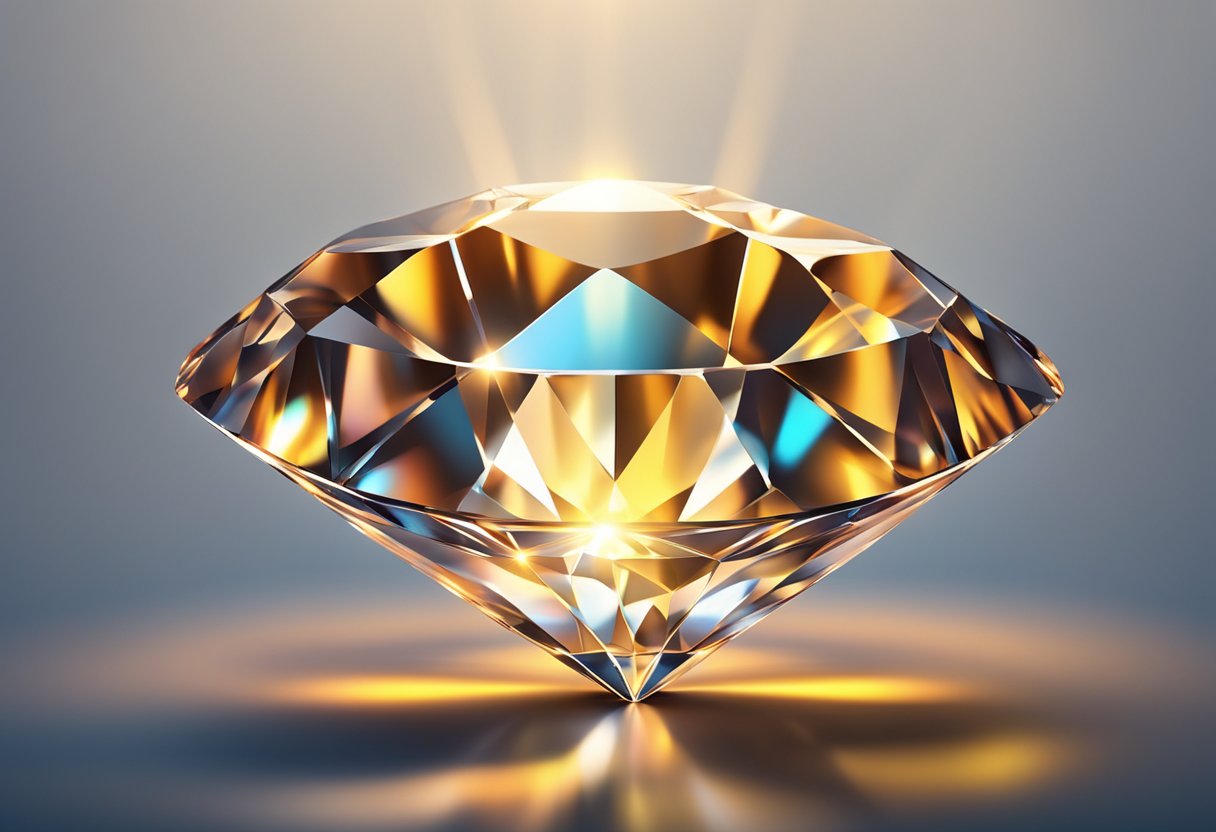
In my exploration of gemstones, particularly diamonds, I've come to understand that their visual allure is largely due to the interactions between light and the diamond's meticulously crafted facets.
Light Behavior in Diamonds
When light enters a diamond, its path changes due to the gemstone's high refractive index. This bending of light, or refraction, is what contributes to a diamond's unique shine. Inside the diamond, light is reflected off the internal facets and is then dispersed or spread out, much like light through a prism where it splits into a spectrum of colors—this is the rainbow effect in gems. Certain cuts of diamonds can lead to light leakage, where light escapes from the bottom or sides of the diamond rather than reflecting back to the observer's eye. This leakage can diminish the perceived brightness of the stone. My goal is to ensure we maximize light performance within a diamond to enhance its fire and brilliance.
Perception of Fire and Brilliance
The term "fire" in diamonds refers to the colorful flashes I observe when the stone is moved under a light source. It's the result of light dispersion, where white light is separated into its component colors. "Brilliance," on the other hand, pertains to the white light reflected back to the observer. My own perception of these elements of sparkle is influenced by various factors. For instance, a smaller pupil size concentrates the light, which may enhance my perception of a diamond's fire. Conversely, larger pupil size could enhance the brightness and white light, impacting how I perceive the diamond's brilliance. The overall light performance of a diamond can be quantified using tools and scales created by industry experts, providing a basis for comparison.
My knowledge of these principles helps me understand why two diamonds of similar size might exhibit differing amounts of fire and brilliance. It reminds me that the beauty of these stones is not just a consequence of their inherent properties but also of the skill and precision employed in their cutting and polishing.
Technical Insights
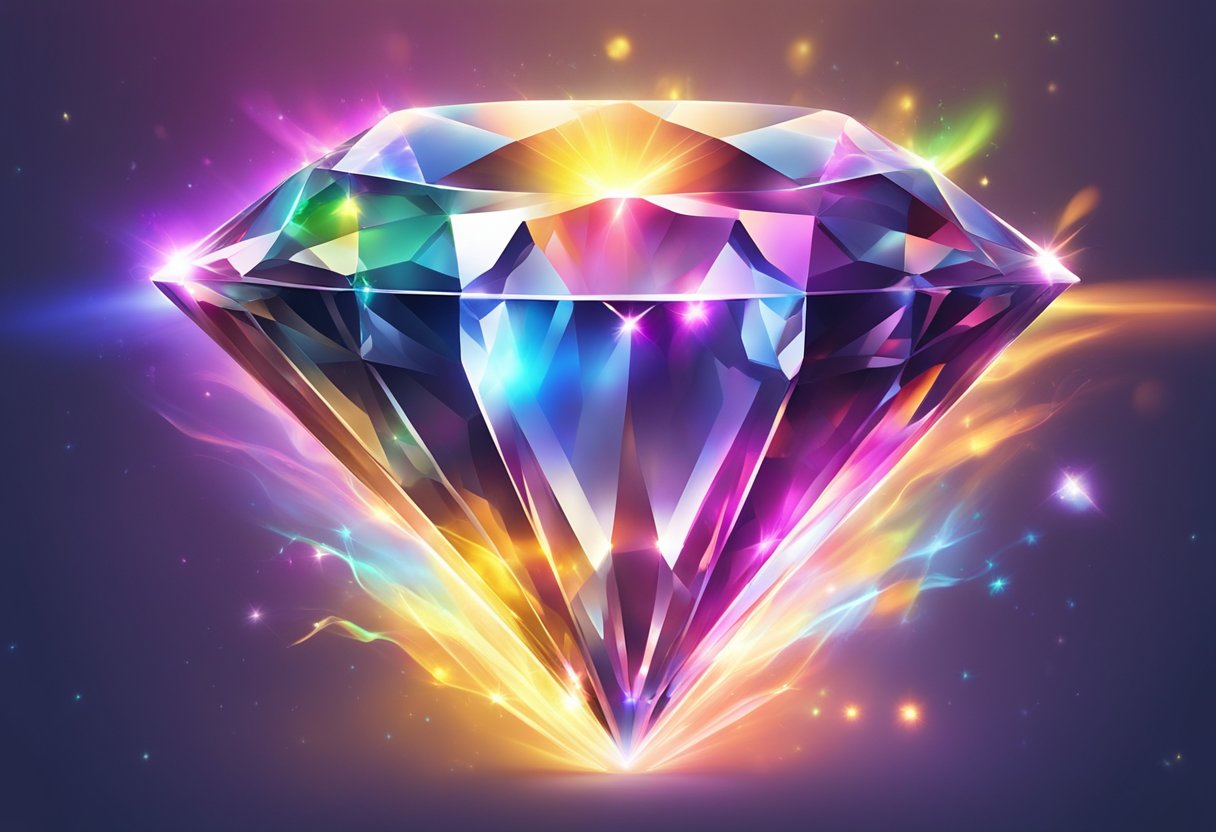
In examining diamond fire, I focus on the optical properties and the sophisticated mathematical techniques that model how light interacts with a diamond's facets.
Optical Science Behind Fire
The phenomenon known as "diamond fire" refers to the dispersion of light into spectral colors. When light enters a diamond, it bends or refracts. This is because a diamond has a high refractive index, a measurement of how much a substance can bend light. As rays of light pass through the diamond and encounter its many facets, they undergo multiple refractions. The bending of light separates the white light into its constituent spectral colors—much like a prism creating a rainbow. The quality and intensity of a diamond's fire are largely dependent on its cut. The cut needs to be precise to ensure that light is not just refracted but also diffused within the diamond before it exits, presenting the dazzling array of colors that diamonds are renowned for.
Mathematical Modeling of Light
The mathematical modeling of light is essential for understanding diamond fire. A technique known as ray tracing is often used to predict how light will behave as it enters, travels through, and leaves a diamond. Ray tracing algorithms simulate the paths of individual rays of electromagnetic energy as they interact with the diamond's facets. By calculating the angles of incidence and refraction, I can predict where the light will go and how it will spread out. This modeling helps diamond cutters optimize the fire by revealing the precise angles at which the diamond should be cut to maximize the bending and diffraction of light, enhancing the visual impact.
Frequently Asked Questions
In this section, I'll address some common inquiries about diamond fire, offering precise and factual answers to enhance understanding of this captivating gemstone characteristic.
What is the phenomenon known as diamond fire?
Diamond fire refers to the dispersion of light into the colors of the spectrum as it passes through a diamond. When white light enters the stone, it breaks down into various colors, resulting in a fiery effect.
How does diamond fire differ from the gemstone's brilliance?
The term brilliance describes the total light reflected from a diamond, which is a measure of its sparkle and overall light performance. In contrast, fire specifically refers to the spectral colors produced by the dispersion of light.
What factors impact the fire observed in diamonds?
The fire observed in diamonds is influenced by the stone's cut, which affects how light is dispersed, and includes the angles and proportions of its facets. A well-cut diamond will show more fire than a poorly cut one.
Can the level of fire in a diamond indicate its overall quality?
While the level of fire can contribute to a diamond's visual appeal, it is only one aspect of several that indicate overall quality. Other factors such as clarity, color, and cut also play significant roles in determining a diamond's value.
Which types of diamonds are renowned for exhibiting the most fire?
Certain diamond cuts, like the round brilliant, are renowned for exhibiting the most fire due to their precise facet arrangements designed to maximize light dispersion.
What is the relationship between diamond fire and the stone's color?
Diamond fire can be observed across different stone colors, but it tends to be more prominent in colorless diamonds, as any coloration in the diamond may affect the purity of the dispersed light, slightly altering the perceived fire.
Checkout some of our top collections:
Leave a comment
Please note, comments must be approved before they are published.

